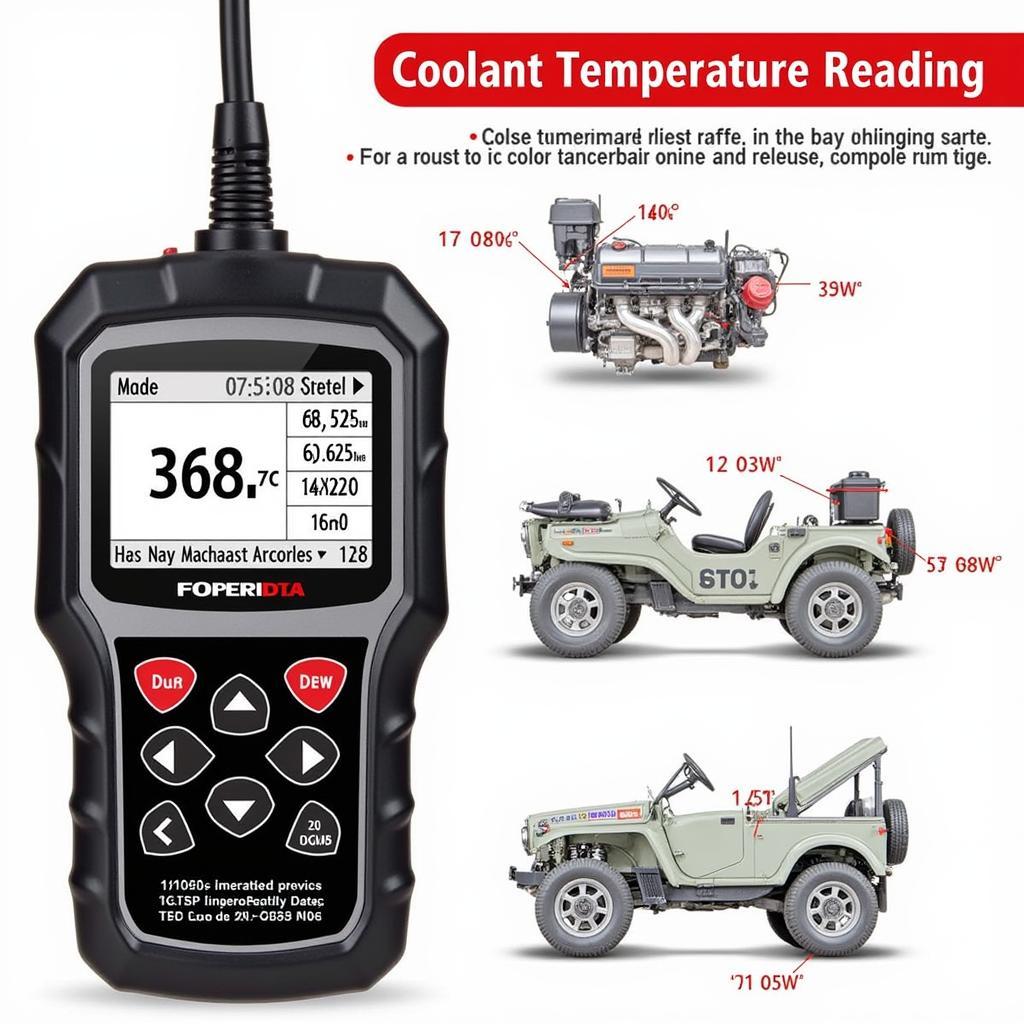Coolant temperature is a critical factor in engine performance and longevity. A Scan Tool Reading Of Coolant Temp provides valuable insights into your vehicle’s cooling system health. Knowing how to interpret this data can help you diagnose potential issues early, preventing costly repairs and ensuring optimal engine operation.
Similar to an obd2 scan tool for iphone, a good scan tool can provide detailed coolant temperature readings. This article will delve into the intricacies of understanding coolant temperature readings, common causes of abnormal readings, and troubleshooting steps you can take.
What Does a Scan Tool Reading of Coolant Temp Tell You?
The scan tool reading of coolant temp reflects the temperature of the engine coolant, which is responsible for regulating engine temperature. This reading is crucial because it indicates whether the cooling system is functioning correctly. A normal operating temperature typically falls between 195°F and 220°F (90°C and 104°C), although this can vary slightly depending on the make and model of your vehicle. Readings significantly outside this range can point towards potential problems.
What are the common issues related to coolant temperature readings? Fluctuations, consistently high or low readings, and slow warm-up times are all signs of potential issues. These issues can range from a simple faulty thermostat to more complex problems like a failing water pump or a head gasket leak.
 Coolant Temperature Reading on a Scan Tool
Coolant Temperature Reading on a Scan Tool
Common Causes of Abnormal Coolant Temp Readings
Why is my scan tool reading of coolant temp inaccurate? Several factors can contribute to abnormal coolant temperature readings. A faulty thermostat, which regulates coolant flow, is a common culprit. A stuck-open thermostat can prevent the engine from reaching optimal operating temperature, resulting in a low reading. Conversely, a stuck-closed thermostat can cause overheating, leading to a high reading.
Another potential cause is a low coolant level. Insufficient coolant can’t effectively absorb and dissipate heat, causing the engine to overheat. Leaks in the cooling system, such as a cracked radiator hose or a faulty water pump, can contribute to low coolant levels.
A malfunctioning cooling fan can also lead to abnormal readings. The cooling fan helps dissipate heat from the radiator, especially at low speeds or when idling. If the fan isn’t working correctly, the engine can overheat, resulting in a high coolant temperature reading.
Similar to a bluetooth car scanner dr mecanico, most modern scan tools provide real-time data that allows mechanics to diagnose issues quickly. This is especially helpful when dealing with intermittent problems that are hard to reproduce in a shop environment.
Troubleshooting Coolant Temp Issues with a Scan Tool
How do you troubleshoot coolant temp issues using a scan tool? A scan tool, even an aldl bluetooth scan tool, is invaluable for diagnosing coolant temperature problems. Beyond simply displaying the current temperature, many scan tools offer features like data logging and graphing, allowing you to track temperature changes over time. This data can be crucial in identifying intermittent problems or confirming the effectiveness of repairs.
Here’s a step-by-step guide to troubleshooting:
- Check the Coolant Level: Ensure the coolant reservoir is filled to the appropriate level.
- Inspect for Leaks: Look for any visible signs of coolant leaks around hoses, the radiator, and the water pump.
- Monitor the Thermostat: Use the scan tool to monitor the coolant temperature as the engine warms up. A slow warm-up or a temperature that doesn’t reach the normal operating range may indicate a faulty thermostat.
- Test the Cooling Fan: Observe the cooling fan operation. It should cycle on and off as needed to regulate temperature.
- Check for Error Codes: The scan tool can retrieve diagnostic trouble codes (DTCs) related to the cooling system, which can provide valuable clues about the underlying issue.
As with compatible scan tool, checking compatibility is essential. Ensure your scan tool is compatible with your vehicle’s make and model for optimal performance.
Conclusion
Understanding your scan tool reading of coolant temp is crucial for maintaining your vehicle’s health. By recognizing abnormal readings and using a scan tool effectively, you can diagnose and address cooling system problems before they escalate into major repairs. Regular monitoring and proactive maintenance can significantly extend the life of your engine and ensure optimal performance.
Need help with your vehicle’s cooling system? Connect with the experts at ScanToolUS for support and advice. You can reach us at +1 (641) 206-8880 or visit our office at 1615 S Laramie Ave, Cicero, IL 60804, USA.
Similar to the ovz car scanner app, many tools can assist you. Remember to consult a qualified mechanic if you’re unsure about any aspect of diagnosing or repairing your vehicle’s cooling system.
FAQs
- What is a normal coolant temperature reading? A normal operating temperature typically falls between 195°F and 220°F (90°C and 104°C).
- What does a low coolant temperature reading indicate? A low reading could indicate a stuck-open thermostat or low coolant levels.
- What does a high coolant temperature reading indicate? A high reading could indicate a stuck-closed thermostat, low coolant levels, or a malfunctioning cooling fan.
- How can I check my coolant level? Locate the coolant reservoir and check the level markings.
- What should I do if I suspect a coolant leak? Inspect for visible leaks and consult a mechanic.
- Can I use a scan tool to diagnose cooling system problems? Yes, a scan tool can be invaluable for diagnosing coolant temperature and other cooling system issues.
- Where can I get help with my car’s cooling system? Contact ScanToolUS for expert advice and support.


